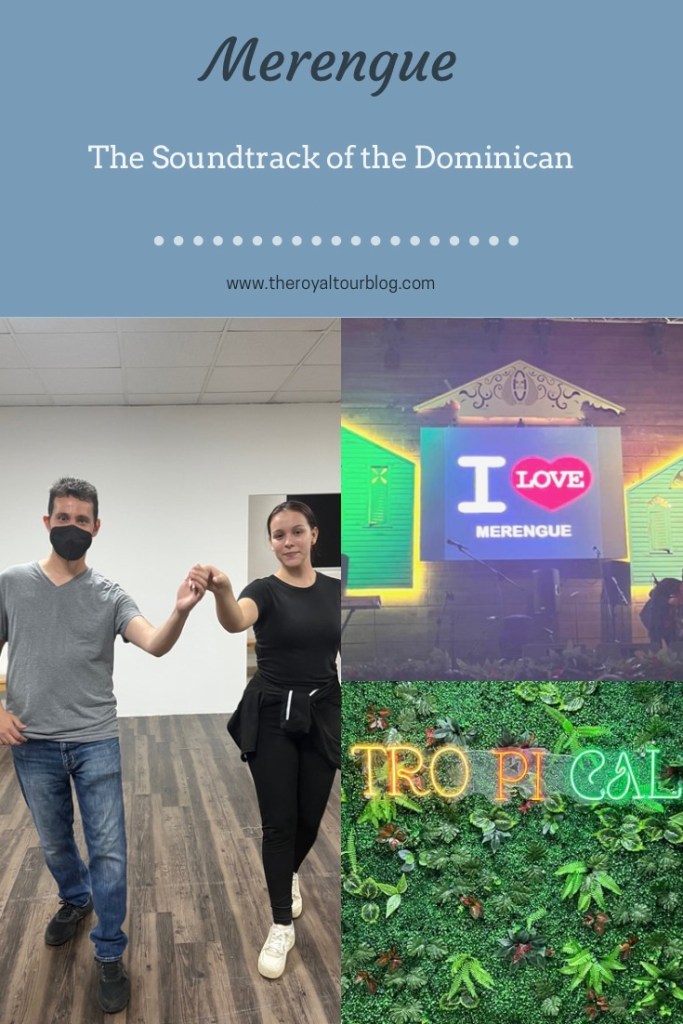Uno y dos y tres y cuatro. Robert’s voice marks the beat as our group of about thirty practices a simple turn, women rotating under the right arm of the men. I count along with him, trying to look at my partner – we rotate every minute or two so that the group can get used to dancing with different styles, and to balance out that men outnumber the women by a decent margin – instead of at my feet. We complete the turn, double high fiving as Robert tells us to rotate, the men moving a spot clockwise.
Uno y dos y tres y cuatro. Tropical Dance Studio is as authentic of an experience as one can have here in Santo Domingo, bustling capital of the Dominican Republic. My class is merengue, but a salsa class finished as I arrived, and a bachata class was beginning as I left. Each was crowded, local young adults (at 42 I’m probably the oldest person in my class) either learning new moves or practicing old ones, some attending as a couple while others participate solo. Robert and Alejandra run this class, a Tuesday night staple. And yes, it is solely in Spanish, so I smile blankly and just try to understand from context and demonstrations. I do ok, as Alejandra smiles at me, saying “mui bien.” I beam.

Merengue is a Dominican music style and dance. It was invented here, a conglomeration of the country’s western, native, and African roots. And while some other musical styles and dances have eclipsed it in popularity among the younger generation, it still holds its own against the heavyweights of Latin sounds. More than anything else, merengue is the soundtrack of the Dominican Republic.
(If you are in Santo Domingo, the actual soundtrack is car horns and motorbike engines, but merengue might be a close second. If you’ve ever visited, you’ll understand.)
Merengue was invented here in the mid-1800s. Originally played with string instruments, by the early 20th century, it was a three instrument style, with one instrument representing each of the three cultures that fed into it: the accordion for the west (replacing strings), the guira (a metal tube that looks like a box grater) for the native Taino, and the tambora (a two headed drum) representing Africa.
Over time, the instrumental arrangements and instruments themselves evolved. Under the dictator Rafael Trujillo, merengue mimicked big band, with huge orchestral arrangements. More recently, the original three instruments have been joined by the saxophone and bass guitar, though some musicians use a full piano or large horns section. These updates have kept merengue relevant both here in the Dominican Republic and worldwide, where the style itself enjoys UNESCO status as an intangible cultural heritage of humanity.
Merengue as a dance is also uniquely Dominican. As Robert explains to our class, one of the things that sets merengue apart from more popular Latin dances like salsa is that it is not done with much of a “walk” step. The couple will turn around each other, but mostly remain in place, with steps being more a rocking motion than actual forward or backward movement. Its simple four- or eight-count rhythm is easy for newbies like me to hear once his verbal counting is replaced by music, though apparently I rock a bit more than I should, as my shoulders don’t keep the totally level place they are supposed to occupy.
Uno y dos y tres y cuatro. I shock myself by loving the class. I came here to experience merengue for this article. And yet, after an hour dancing with people I don’t know – all of whom are enthusiastic and welcoming, it must be said – and taking instruction in a language I don’t speak, I have a good enough time that I decide to return the following week! (For those of you who actually know me and my general aversion to dancing, you know how big of a deal this is.) And the beat, the ever-present beat, continues in my head for the six days off between.

For those people who want to experience merengue in its birthplace, here in Santo Domingo you have options other than taking a class with locals, although I can’t recommend this experience highly enough. The Renaissance Hotel here has a Merengue Club, as does the Colonial Zone, and live music can be heard nightly. Or check out the Colonial Zone’s Jalao restaurant, a superb space also featuring live music (though be aware the music on Saturday nights doesn’t begin until 9pm, and you’ll need an advance reservation).

Uno y dos y tres y cuatro. Over the course of the hour-long class, moves get a little more complicated, from the basic spin to dual spins passing each other, to even harder combos where I have to switch hands. I mess up a few times, as do my partners, and we all laugh, which is universal in both Spanish and English. A few more double high fives, some more “biens”, and the class ends in hugs and a little cheer. I exchange contact information with Alejandra, promising to keep in touch, though our language skills overlap little. But a bond built dancing seems like a solid foundation for a new friendship.
Back at my Santo Domingo apartment, I am still smiling, still beaming, and still mentally counting the beat. Few experiences I’ve ever had while traveling feel as real and local as this one, one that has immersed me into an art form that came from right here in this place. Merengue is the soundtrack of the Dominican Republic, a soundtrack that now includes a little bit from me.
Thank you so much to Tropical Dance Studio for warmly welcoming me, and treating me to your amazing merengue class. Thank you also to Robert and Alejandra for your patience in having a non-Spanish speaker in your midst.

Like it? Pin it!
